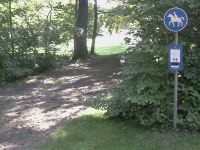FR:Path controversy
Rapid rappel
Il y a différentes manières, règles ou panneaux en usage dans différents pays pour un bon nombre de voies accessibles aux usagers piétons, cyclistes et hippiques. Les tages peuvent varier, surtout avant l'introduction de highway=path et cela a abouti à une conception divergente sur qu'impliquent les tags actuels:
- highway=footway ;
- highway=cycleway ;
- highway=path ;
- foot=designated ;
- bicycle=designated.
Cette page a pour but de rassembler les points de vue actuels et les besoins.Comme la clé highway=* se définit comme "une description très générale et parfois vague de l'importance de la route" (auparavant "de la structure physique de la route"), on doit préciser le "quelque chose" - que ce soit "quelque chose qui n'est pas pour les voitures" ou "pour certains transports spécifiquement" - ça n'est pas clair.
Points sur lesquels tout le monde s'accorde
- highway=footway
- Quelque chose, où marcher est autorisé et possible pour quelqu'un. (walking might be and is allowed and possible elsewhere, too)
- highway=cycleway:
- Quelque chose, où le cyclisme est autorisé et possible
- L'accès piéton n'est pas précisé - peut dépendre du pays mais non supporté actuellement, donc il y a toujours une indication dans le wiki pour l'utiliser avec foot=no/yes/designated.
- highway=path:
- Quelque chose qui n'est pas assez large pour un véhicule à quatre roues.
- OU où les véhicules à moteur sont interdits (à moins d'une indication avec snowmobile/agricultural=designated ou autres).
- N'importe quoi avec wheelchair=no:
- Non carrossable pour les usagers en chaise roulante ou autre difficulté de mobilité
- N'importe quoi avec highway=footway + foot=no (+ snowmobile=yes) est idiot.
- highway=track
- Implique que c'est suffisamment large pour passer avec une petite voiture, même si c'est illégal.
Différents types de voies
Kinds of paths
| Description | wheelchair | foot | bicycle | horse | Tags avant l'arrivée de path |
|---|---|---|---|---|---|
| Chemins non maintenus | no | yes | pays | pays | highway=footway |
| Accès piéton indiqué/impliqué seulement | yes | yes | no | no | highway=footway |
| Indiqué pour vélos seulement | no | no | yes | no | highway=cycleway + foot=no |
| Indiqué pour un usage mixte Indiqué "sans véhicules à moteur" Pas d'indication mais les règles locales autorisent piétons et vélos |
yes | yes | yes | panneau | highway=cycleway + foot=yes |
| Pour chevaux | no | pays | pays | yes | highway=bridleway |
| Pour motoneiges/autres | no | no | no | no | highway=footway + foot=no |
- Panneau Doit être tagué en fonction du panneau utilisé .
- Pays Dépends des valeurs par défaut du pays et dont les droits et exceptions sont tagués.
Par accès
| Example (signposted ways) | Pedestrian in UK | Continental pedestrian | Scandinavian pedestrian | Hiker | Cyclist | Mountain- bike |
Horse | Wheelchair |
|---|---|---|---|---|---|---|---|---|
| "Way for pedestrians" | yes | yes | yes | yes | no | no | no | yes |
| "Way for cycling only" | yes | no | no | no | yes | yes | no | no |
| "Combined cycling and pedestrian way" | yes | yes | yes | yes | yes | yes | no | yes |
| "No motor vehicles" | yes | yes | yes | yes | yes | yes | no | yes |
| Built, even way with no signs at all | yes | yes | yes | yes | yes | yes | no? | yes |
| Example (not signposted) | Pedestrian in UK | Continental pedestrian | Scandinavian pedestrian | Hiker | Cyclist | Mountain- bike |
Horse | Wheelchair |
| Even unbuilt trail Could be wear marks on a park grass or a solid forest trail; people will consider it suitable if not in high heels |
permissive | permissive | yes | yes | yes | yes | permissive/yes per country | no |
| Narrow unbuilt trail Where a urban person wouldn't wan't to be routed over |
permissive | permissive | yes | yes | no | yes/permissive | yes/permissive per country | no |
| Signposted for horses | yes | no | no | no | no (UK, yes) | no | no | yes |
| Signposted for snowmobiles | n/a | n/a | no | no | no | no | no | no |
Nine kinds of ways and four highway classes.
- Bridleway hasn't been contented - legally allowed/reserved for equestrian use.
- Is a cycleway only for bicycles or is combined way also a cycleway? Do they need different rendering?
- In the past both were highway=cycleway, now opinions differ.
- It varies with country which type is more common, if not equally common.
- IMO: it's a rendering issue.
- Is a way for both cyclists and pedestrians any different from a way signposted as "no motor vehicles"?
- IMO: no, and their highway classification should be the same. Alv 15:35, 12 August 2009 (UTC)
- Is a narrow uneven trail different enough from a paved sidewalk or other signposted and modern built footway? (Where foot access on both is legal).
- IMO: yes, their highway classification should be different. Alv 15:35, 12 August 2009 (UTC)
- If yes, where to draw the line?
- Should snowmobile ways even be highways? They're legally binding and defined in the same law as other traffic regulations.






